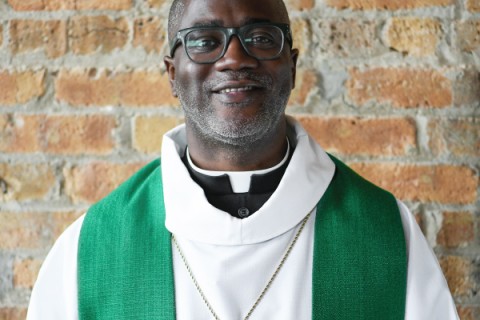Foolish prayer: “Pray as you can, not as you can’t”
Six years before he died, American philosopher William James filled out a questionnaire about religious experience. He was asked, among other things, “Do you pray?” His answer was forthright: “I can’t possibly pray. I feel foolish and artificial.” And yet James wrote, in The Varieties of Religious Experience, that prayer is “the very soul and essence of religion” and that in prayer “work is really done, and spiritual energy flows in and produces effects.” It’s well known that James longed to experience such effects in his own life, yet he remained trapped in his pragmatic corridor, generously holding open the door to prayer for others but unable to enter it himself.
I wonder if it ever occurred to William James that feeling foolish and artificial is as good a starting point as any for prayer. Prayer is like courtship; of course it feels foolish and artificial. It’s not something you can work out inwardly and then execute outwardly. It’s a series of improbable and ungainly gestures, learned by imitation, that make it possible to fall in love. Perhaps I see it this way because as a chronic beginner at prayer, I often feel foolish and inept.
Lately I have been learning about prayer-courtship from the rosary. What could be more improbable and ungainly than this prayer of incessant repetition, learned by imitation and practiced by rote?
According to Friedrich Heiler’s 1932 classic Prayer, rote prayer is a sign of hardening of the spiritual arteries:
Prayer is at first a spontaneous emotional discharge, a free outpouring of the heart. In the course of development it becomes a fixed formula which people recite without feeling or mood of devotion, untouched both in heart and mind. At first prayer is an intimate intercourse with God, but gradually it becomes hard, impersonal, ceremonial, a rite consecrated by ancestral custom. . . . Even among primitive peoples this process of petrification and mechanization . . . transforms free prayer into precise and rigid formulas.
To many Christians the rosary embodies all the vices of “petrification” to which Heiler alludes: precise and rigid formulas, vain repetition, conformity, credulity and works-righteousness, compounded by Mariolatry, triumphalism and superstition. Many have been ready to see the practice die out—not only Protestants who consider the petrification of prayer a peculiarly Petrine liability, but also Catholics for whom the rosary is like a woolly mammoth blocking the door to liturgical reform.
But it hasn’t died out. How many thousand Hail Marys, Our Fathers and Glory Bes are being struck on the rosary strings at this very instant across the globe? The rosary encircles the world like a magnificent Tibetan prayer wheel, spinning out adoration. It’s a giant carousel you can climb upon at any point and step off again, knowing that the prayer will keep going with or without you; tradition has seen it as the liturgy in miniature, mirroring in its 15 decades the 150 psalms, as a potent means of intercession, a weapon against the forces of darkness, a reparation for human sin, and a tried-and-true means of initiation into the mysteries of Christ. Like the Jesus Prayer of the Christian East, the rosary is cherished as a compendium of the Gospels, a temple of the divine name and a heaven-sent method for fulfilling the biblical injunction to “pray without ceasing.”
The rosary is also a school of prayer for lifelong beginners like me, and increasingly it is being rediscovered as a way of prayer for all Christians. Within the Anglican communion it has flourished for some time. Evelyn Underhill loved the rosary and so did Austin Farrer. John Macquarrie commends it in his book Mary for All Christians. With his apostolic letter of last October, Rosarium Virginis Mariae, Pope John Paul II set a small fire under this process of ecumenical rediscovery by offering an intensely Christocentric and contemplative interpretation of the rosary. Most remarkably, he introduced a fourth series of mysteries on which to meditate: the lucis mysteriis, or “mysteries of light,” focusing on events in the public ministry of Jesus Christ: his baptism in the Jordan, first miracle at Cana, preaching of the kingdom, transfiguration, and institution of the Eucharist.
According to the pope, the rosary is a Christian zakar (remembrance) of Christ through Mary. One thinks of the Sufi zikr, remembrance of God through repetitive prayer. My Tibetan friend Dechen practices buddhanusmrti, remembrance of the Buddha, with the aid of his 108-bead rosary. To outsiders such practices may look like mumbo-jumbo, but those who pray them know how they can train the spirit to make a free and loving response to the divine call. Our heart beats repetitively while our mind wanders. The rosary brings the straying mind down to the repeating heart, quiets the mind and centers the gaze, with Mary, on the face of her beloved son.
“Pray as you can,” John Chapman used to say, “not as you can’t.” We can be dry as dust, bored, distracted and insensible to God’s presence. Still we can pray, mechanically if need be, taking refuge in whatever means have been given. We can rest on the rosary as a climber rests on his fixed rope—it’s safe to dangle as long as the rope is anchored in rock. We may not have a mystical bone in our bodies, but no matter. God is waiting for us, and if we make even the smallest gesture of availability he will be there, whether we feel his presence or not.




